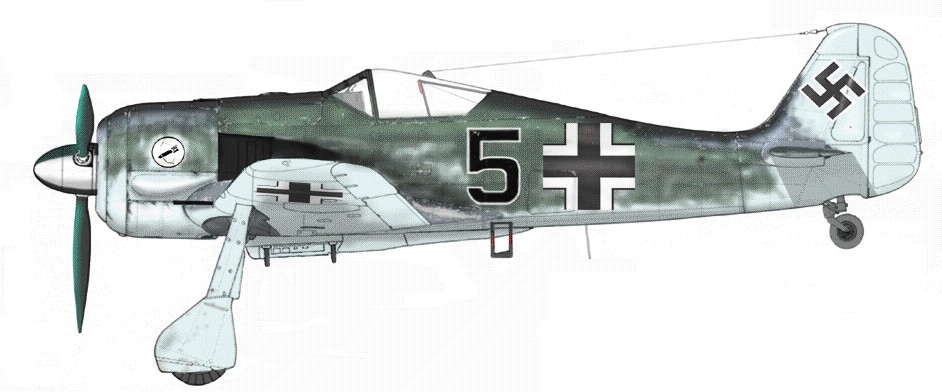| Date |
Pilot & Fate |
Type |
W.Nr |
Markings |
Remarks |
Location |
% |
F/H |
| 18.02.43 |
? |
FW 190 A-3 |
0132 274 |
? |
Landing accident |
Fl.Pl. Alta |
30 |
H |
| 10.03.43 |
- |
FW 190 A-3 |
0132 255 |
? |
Bombing raid |
Fl.Pl. Petsamo |
10 |
F |
| 20.03.43 |
Fw. Friedrich Hammesfahr W |
FW 190 A-3 |
0132 268 |
? |
Shot down, later returned to unit |
Severomorsk |
100 |
F |
| 27.03.43 |
? |
FW 190 A-2 |
0125 495 |
? |
Belly-landing due to engine trouble |
S. Fl.Pl. Alta |
15 |
H |
| 29.03.43 |
? |
FW 190 A-3 |
0132 254 |
? |
Pilot error while landing |
Fl.Pl. Petsamo |
60 |
F |
| 05.04.43 |
Uffz. Kurt Dobner + |
FW 190 A-3 |
0130 323 |
'Black 14 + ' |
Anti-aircraft fire |
W. Hormasi |
100 |
F |
| 13.04.43 |
Uffz. Kurt Wendler + |
FW 190 A-3 |
0132 215 |
'Black 1 + ' |
Anti-aircraft fire, pilot bailed out |
N. Fl.Pl. Petsamo |
100 |
F |
| 11.05.43 |
Lt. Günther Busse + |
FW 190 A-3 |
0130 524 |
'Black 7 + ' |
Anti-aircraft fire |
Rybaci |
100 |
F |
| 22.05.43 |
Lt. Klaus Biwer + |
FW 190 A-3 |
0132 102 |
'Black 3 + ' |
Anti-aircraft fire |
Cap Cypnavolsk |
100 |
F |
| 17.06.43 |
Oblt. Karl-Friedrich Koch - |
FW 190 A-3 |
0130 471 |
? |
Engine trouble, pilot bailed out |
Fl.Pl. Petsamo |
60 |
H |
| 18.06.43 |
Uffz. Walter Pohl + |
FW 190 A-3 |
0135 528 |
'Black 8 + ' |
Anti-aircraft fire |
2 km W. Cap Pogan |
100 |
F |
| 18.06.43 |
Fw. Walter Hünlein + |
FW 190 A-3 |
0135 488 |
'Black 9 + ' |
Hit the mast of vessel |
N. Cap Pogan |
100 |
F |
| 07.07.43 |
Hptm. Friedrich Wilhelm Strakeljahn - |
FW 190 A-3 |
0135 508 |
'Black 5 + ' |
Crash-landing due to anti-aircraft fire |
Fl.Pl. Petsamo |
30 |
F |
| 01.08.43 |
Ofw. Böttger - |
FW 190 A-3 |
0132 255 |
? |
Hit by anti-aircraft fire |
Pummanki |
100 |
F |
| 01.08.43 |
? |
FW 190 A-3 |
0135 446 |
? |
Pilot error |
Fl.Pl. Petsamo |
20 |
F |
| 18.08.43 |
? |
FW 190 A-3 |
0132 167 |
? |
Anti-aircraft fire |
Eina Bight |
10 |
F |
| 05.10.43 |
Fw. Berthold Reichel W |
FW 190 A-3 |
0130 523 |
'Black 15 + ' |
Became lost, ran out of fuel, pilot bailed out |
40 km W. Passvik |
100 |
F |
| 05.10.43 |
Uffz. Hans-Günther Kleemann W |
FW 190 A-3 |
0132 219 |
'Black 3 + ' |
Became lost, ran out of fuel, pilot bailed out |
40 km W. Passvik |
100 |
F |
| 28.10.43 |
? |
FW 190 A-3 |
0137 012 |
? |
Landing accident |
Fl.Pl. Petsamo |
10 |
F |
| 25.11.43 |
- |
FW 190 A-3 |
0130 399 |
? |
Bombing raid |
Fl.Pl. Petsamo |
20 |
F |
| 29.12.43 |
Fw. Helmut Kuhlemann + |
FW 190 A-3 |
0132 167 |
? |
Anti-aircraft fire |
Rybaci |
100 |
F |
| 14.02.44 |
Lt. Karl-Heinz Froschek W |
FW 190 A-3 |
0132 179 |
'Black 2 + ' |
Crashed after being hit by anti-aircraft fire |
E. Kiestinki-Louhi |
100 |
F |


